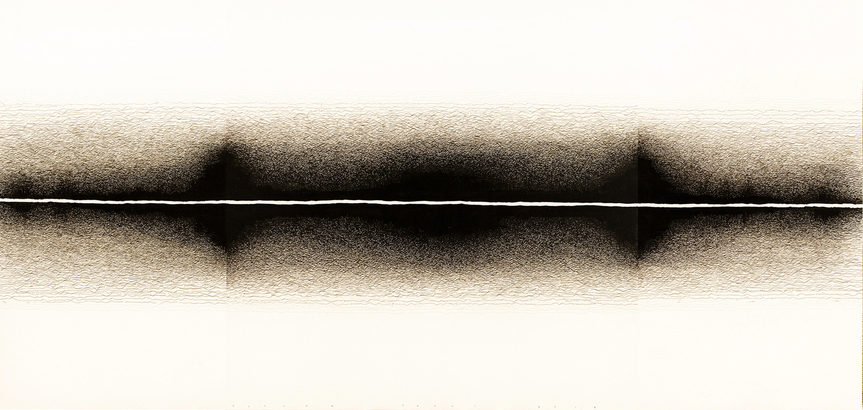-
From Current Issue
-
- Editor’s Letter Fire in the Heart
- Reviews I Gusti Ayu Kadek Murniasih
- Reviews 11th Seoul Mediacity Biennale: “One Escape at a Time”
- Dispatch Networked China
- One on One Monira Al Qadiri on Yukio Mishima
- Essays The rise of independent art spaces in pandemic-era Shanghai
- Features Tuan Andrew Nguyen
- Table of Contents
- Web Exclusives
- Archive
- Subscribe

R
E
V N
E
X
T
Installation view of GOLNAZ FATHI’s “A Long Line Without a Word,” Pearl Lam Galleries, Shanghai, 2018. All images courtesy the artist and Pearl Lam Galleries, Hong Kong / Shanghai / Singapore, unless otherwise stated.
The walls, painted in gray, white and ebony to match the tones in the paintings, told of sensitive preparation for Golnaz Fathi’s solo exhibition. Without asserting thematic divisions, the shades of the walls reflected changes of mood and style in the artworks. Minimalist pieces yielded to paintings in which fine gestures amassed to become entwined forms, while the space eventually changed from a clinical white to theatrical darkness, punctuated by the luminous scrawl of lines projected onto a wall.
The first uncluttered works fitted Pearl Lam’s Shanghai space as if the reserved detail of the gallery’s art deco architecture were also part of the exhibition design. Four untitled paintings (all works 2017) resembled architectural
plans of empty spaces with a single central feature, or entrances disposed symmetrically. These elements took the form of precisely defined square
inserts in the rectangular canvas, fading from black to pure white. The effect corresponded with the 90-degree angles of the ceiling’s deep coffers. Light falling on this feature produced an ordered range of grays, a gradation deftly paralleled in paint, applied in minute and precise gestures.
This technique, using small recurrent lines that are only actually visible close up, was seen in other works, such as Life Goes On. The line is pencil thin, relaxed and supple, starting with a gentle inflection from the left; wavering but sure of its overall course, it ends with a resolute right turn. This small drawn element, less than the length of a finger, tells of a delicate hand movement, reiterated side by side in alignment, at a particular place on the canvas, while other areas remain untouched. Using such a spindly element to create substance, on surfaces that are of a corporal scale, requires forbearance, building up layers until black is formed by density, and the unity of discrete marks is lost. Fathi associates the method to a warm-up exercise in Persian calligraphy. Freedom is attained through discipline. Only rarely does Fathi permit a spontaneous line to leap free.
Another exacting technique is applied in a trio of gray canvases, also all untitled. Each has either two or four broad strokes that start in an accumulation of white. Once deposited, the paint trails off into strands recording the drag of single bristles. These too are soon released from the surface, leaving the leaden background color untouched. An untitled quadriptych reverses the effect, with black intruding into white. One panel is dark, as if in intense shadow. Broad, flat brush strokes spill from the perimeter of this section, giving way to tendrils of calligraphy. Out of My Hands, a triptych, also adopts the gesture, this time in a vertical orientation. The design suggests the graphical image of acoustic intensities, like a voice building and fading away.
Knotted Roots, another triptych, spotlit in a darkened area of the gallery, connects with a brief wall text by Fathi that states: “Roots hidden within the soil grow closely to each other, yet remain intact and separate from all the other roots nearby. Each line tells its own story.” On a white background, twisting filaments are interwoven. Like mycorrhiza, cultured in a rarefied atmosphere, their interconnections are frail but their impetus is of inexorable curiosity. It is possible to skirt around the back of the partition where the painting hangs and enter a darkened area where a video is projected onto the reverse of the wall. Entitled Seasons Changing, there is no discernable animation, just a faint violet glow that reproduces the contours of Knotted Roots, as if the life force traced in the design had burned right through the wall, suggesting the roots’ potent impetus. Fathi does not reveal the nourishment the roots seek, nor any threat that has forced them underground.
Fathi’s painted calligraphy is always sealed beneath a sheen of satin varnish. The pristine smoothness suggests detachment, highlighting the inscrutability of characters that indicate direction, but never form letters or join to make words, only telling of general principles—of the limited choices faced in life, perhaps: to go forward, to deviate, to enter, to probe, to get tangled up, to fade, to wither, to grow.
Golnaz Fathi “A Long Line Without a Word” is on view at Pearl Lam Galleries, Shanghai, until July 22, 2018.
To read more of ArtAsiaPacific’s articles, visit our Digital Library.







